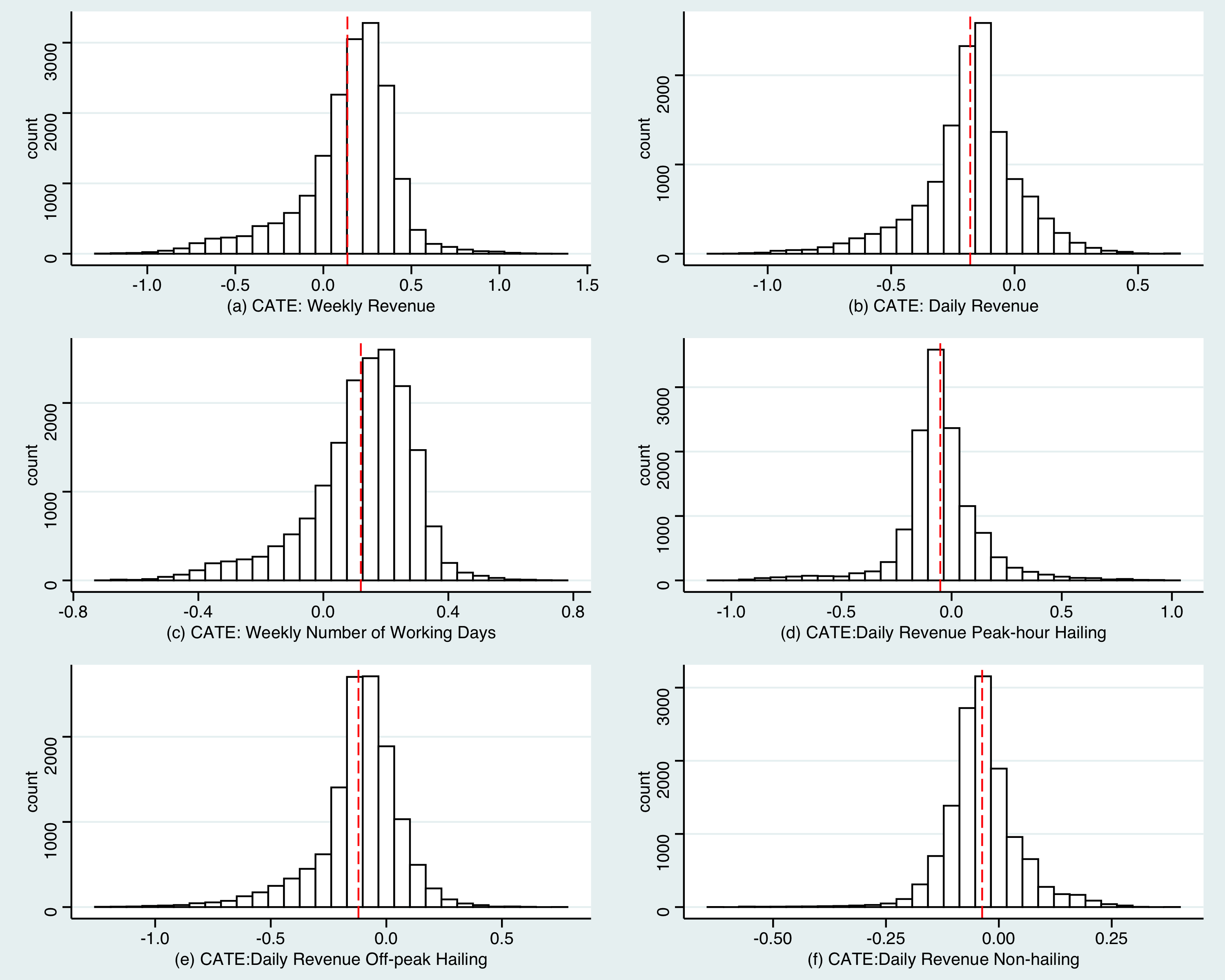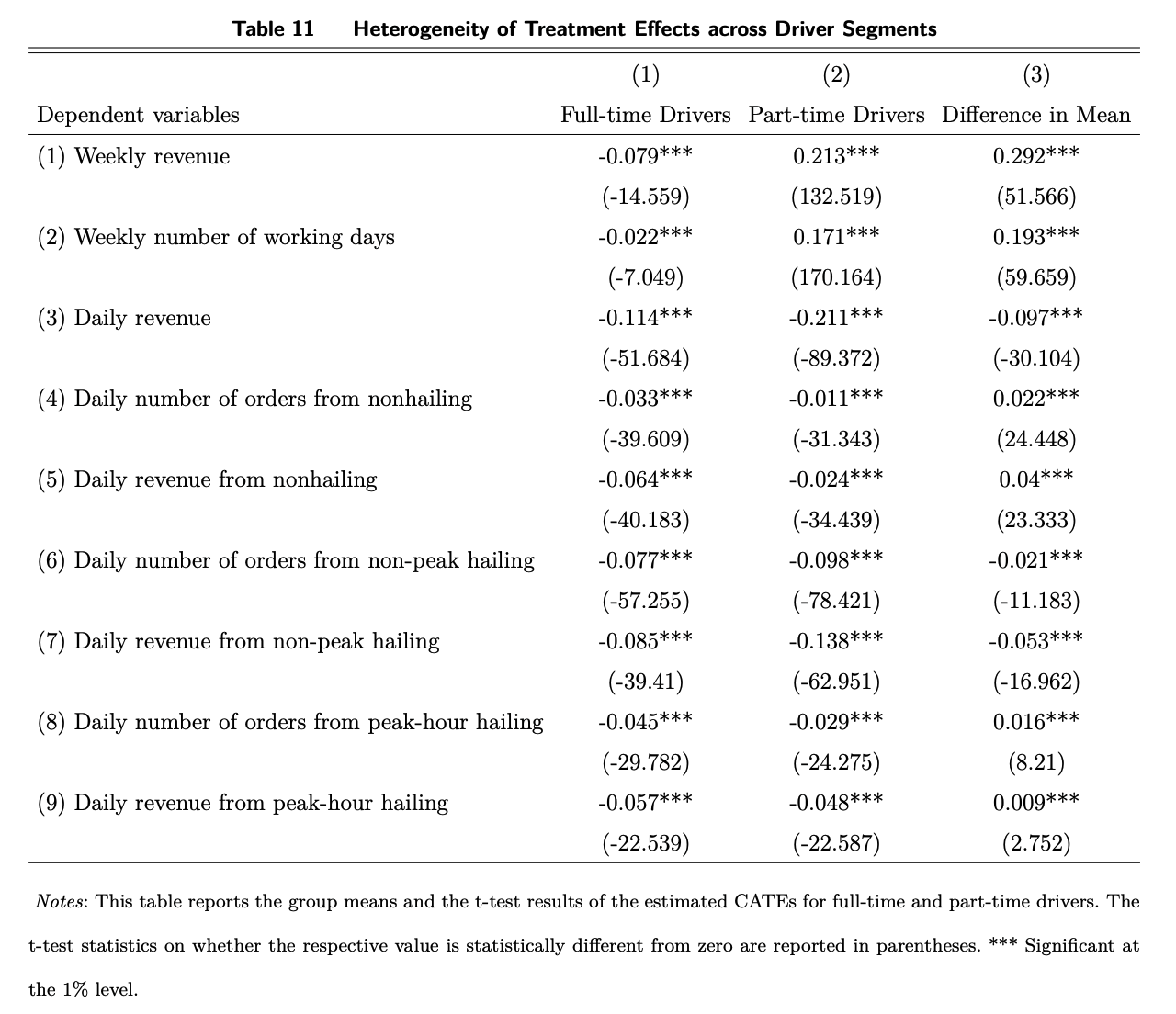The Effects of Surge Pricing on Driver Behavior in the Ride-Sharing Market: Evidence from a Quasi-Experiment
Miao Wei, Yiting Deng, Wei Wang, Yongdong Liu, and Christopher Tang. 2022. Journal of Operations Management, 1–29. [link]
1 Abstract
Surge pricing has been used to coordinate supply and demand in the ride-sharing industry, but its causal effects on driver behavior remain unclear. This motivates us to examine how surge pricing causally affects driver earnings and labor supply by leveraging a unique quasi-experiment, in which a leading ride-sharing company in China introduced surge pricing in two cities at different times. Using a difference-in-differences design with the causal forest method, we find that surge pricing led to increases in drivers’ weekly revenue. Decomposing the weekly revenue into “intensive margin” and “extensive margin” factors, we discover two countervailing effects at play: a cherry-picking effect and a competition effect, and the daily revenue decreased because the latter dominated. Consequently, the increased weekly revenue can be explained by the extensive margin: drivers worked on more days to compensate for the decreased daily revenue, a result consistent with the income targeting behavior. Finally, we examine heterogeneous treatment effects across drivers, and find that surge pricing enticed more part-time drivers to flood the market and crowd out full-time drivers, and that the increase in the drivers’ weekly revenue was primarily driven by part-time drivers. Therefore, the benefit of surge pricing was unevenly distributed across drivers.
2 Problem Definition
Surge pricing has been widely used in various contexts, including ride-sharing markets, to coordinate supply and demand. However, previou studies have yielded mixed results on the effects of surge pricing on driver behavior. In this research, we aim to investigate the causal effects of surge pricing on driver earnings and labor supply, and shed light on how the effects of surge pricing vary across different types of drivers.
3 Theoretical Framework
Figure 1 explores how surge pricing impacts drivers’ weekly revenues and labor supply decisions. Focusing on revenue is crucial because it directly relates to driver welfare and platform revenue due to the revenue-sharing model. Surge pricing’s effects on driver revenue can influence both intensive (hours worked per day) and extensive (days worked per week) labor supply factors.
We break down weekly revenue into intensive and extensive margins based on the labor supply literature.
- Extensive margins refer to the number of days worked per week, with potential variations across drivers based on their pre-treatment capacity.
- Intensive margins measure how intensively a driver works given that the driver works on a day, including the number of off-peak hailing trips, peak-hour hailing trips, and nonhailing trips.
The hypotheses are based on two economic theories: neoclassical labor supply theory and reference-dependence theory. These frameworks help explain how surge pricing may influence labor supply decisions, which is particularly relevant to flexible workforces like ride-sharing drivers.
3.1 Surge Pricing and Intensive Margin Factors
Drawing from neoclassical labor supply theory, we hypothesize that surge pricing encourages drivers to prioritize more profitable hailing trips, especially during peak hours, over less profitable nonhailing or off-peak hailing trips. This leads to the following hypothesis:
- H1A: Surge pricing reduces revenue from nonhailing and off-peak hailing trips due to cherry-picking behavior.
However, competition may intensify among drivers during peak hours, offsetting the benefits of surge pricing. Hence, we propose:
- H1B: Surge pricing does not increase revenue from peak-hour hailing trips due to heightened competition.
Considering both effects, we conjecture that surge pricing may ultimately reduce a driver’s overall daily revenue:
- H1C: Surge pricing decreases daily revenue for a driver.
3.2 Surge Pricing and Extensive Margin Factors
According to reference-dependent preferences theory, drivers may adjust their weekly workdays to reach income targets. Unlike taxi drivers, ride-sharing drivers tend to focus on weekly rather than daily income targets. Surge pricing may prompt drivers to work more days to compensate for reduced daily revenue:
- H2A: Surge pricing increases the number of working days per week for a driver.
Furthermore, the treatment effects may differ based on whether a driver is part-time or full-time. Part-time drivers, who have more flexibility, are expected to show a larger response to surge pricing:
- H2B: Part-time drivers experience a stronger surge pricing effect on their working days than full-time drivers.
4 Data and Methodology
We collect detailed trip-level data from a leading Chinese ride-sharing company, including driver earnings, trip types, and trip times. The data cover two cities where surge pricing was introduced at different times, allowing us to leverage a quasi-experimental design. We use a difference-in-differences (DID) identification strategy to identify the causal effects of surge pricing on driver behavior. The DID estimator compares the changes in driver behavior between the treatment and control groups before and after the introduction of surge pricing.
To operationalize our DID estimation, we apply the causal forest algorithm, which is a nonparametric machine learning method that can handle high-dimensional data and nonlinear relationships. The causal forest algorithm allows us to estimate heterogeneous treatment effects across different types of drivers, such as part-time and full-time drivers.
5 Key Results
5.1 Average Effects of Surge Pricing
- Weekly Revenue Increase: Surge pricing led to a significant increase in drivers’ weekly revenue by 13.7%. This result contrasts with previous studies that suggested surge pricing decreases driver welfare.
- Cherry-Picking Effect: Drivers responded to surge pricing by shifting from nonhailing and off-peak hailing trips to peak-hour hailing trips. This resulted in a reduction in daily revenue from nonhailing trips and off-peak hailing trips.
- Competition Effect: Although surge pricing increased the number of peak-hour hailing trip requests, the increased competition among drivers offset the potential revenue gains from these trips, resulting in no significant increase in revenue during peak hours.
- Decreased Daily Revenue: Despite cherry-picking, the competition effect led to a net decrease in daily revenue, supporting the hypothesis that surge pricing lowers drivers’ earnings on working days.
- More Working Days (Extensive Margin): Drivers compensated for their lower daily revenue by working more days per week. The number of working days increased significantly by 12.1%.
- Shift Allocation: The increased workdays were primarily allocated to weekday night shifts, with a decrease in weekend day work, indicating a strategic response to maximize earnings during more profitable times.
5.2 Heterogeneous Treatment Effects across Driver Segments
- Heterogeneous Treatment Effects: The causal forest algorithm returns indivdual treatment effects for each driver. The distribution is plotted in Figure 2. Significant heterogeneity in individual driver responses to surge pricing is observed, particularly in weekly revenue. The individual CATEs for weekly revenue ranged from -1.266 to 1.328, with a standard deviation more than double the mean, indicating diverse effects across drivers.
- Part-time vs. Full-time Drivers: We focus on the differential impact of surge pricing on part-time and full-time drivers. We use K-means clustering to identify two distinct driver segments based on their pre-treatment work schedules. We then estimate the treatment effects on the 2 segments in the following table:
We find that surge pricing enticed more drivers to participate, particularly part-time drivers. As a result, competition among drivers intensified, resulting in revenue loss on given working days. Full-time drivers were discouraged and worked on fewer days, but part-time drivers made up for their loss by working on more days.
To conclude, while the “pie” got larger and the driver pool got even larger, the slice per driver did not increase. In the end, even though surge pricing created more value, the increased wealth was distributed unevenly across full-time and part-time drivers.
Our results highlight the importance of accounting for individual heterogeneity when analyzing the effect of surge pricing, which has not been explored in most structural analyses of surge pricing in the literature.


